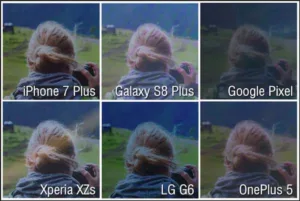Summertime is here and with it come a lot of complaints about the readability of displays and mobile displays in particular. This is especially true for the Northern hemisphere where the sun is now high in the sky and most displays that are exposed to direct sunlight pretty much render themselves useless.

If you believe that this observation is a thing of the past I want to remind you that at this time even the best smartphone displays still suffer significant image degradation no matter what display technology is being used.
In the following images PhoneArena.com compared the displays of several late model smartphone displays in an outdoor situation. As you can see, the different displays react quite differently. According to their comparison, the Samsung Galaxy S8 Plus, Sony Xperia XZs and iPhone 7 Plus are the winners while the other displays show much more image degradation.
Image: PhoneArena.com – Smartphones under sunlight
From a display standpoint, this comparison is a good starting point as it evaluates the images with the eye and most people would put the respective models in a similar order. However, here comes the issue; what we typically use as a measure for display quality, is a combination off different measurements that are mostly performed in a dark room to eliminate any influence of ambient light on the measurement itself. This approach was created to make display rankings more like an ‘Apple to Apple’ comparison rather than one where the brand with the most clever conditions wins. We are used to this from the projection industry, where these discussions have continued for many years and will continue from now. From a user’s perspective the comparisons are completely useless as the ambient conditions change throughout the day and with the changes, the perceived display quality will alter.
In these circumstances, the empirical test approach from PhoneArena.com may make much more sense and provide a more meaningful result.
As we can see, the display technology is not necessarily the most important characteristic as the Samsung with its AMOLED display is arguably quite good, while the Google Pixel and the OnePlus 5 do not live up to the same standard. The LCD displays on the Sony and Apple devices are quite good as well, while the same technology is not quite as good on the LG G6.
Antireflective Coatings make the difference
All smartphones come with some form of antireflective coatings to mitigate ambient light conditions. This is where the leaders seem to have an advantage over other brands. Antireflective coatings are tricky and putting together the right setup is a little bit of art combined with sound physics. If ray tracing algorithms could be 100% correct, all of the brands would have the same great outdoor performance. As we can see, this is not the case. Of course, there is also the question how much money the brand wants to invest in this technology. I guess this is a question of market positioning as much as pricing.
When you add to this equation the fact that many smartphone users have a protective panel on top of the display, you can’t even blame the brand’s decision but your own as you buy the protective panel and glue it on the front.
Power demand limits display brightness
All of the phones in the image have (automatic) brightness settings and dial up the brightness as the ambient light increases. This has a limit, of course, as the backlight or OLED cells have a maximum light output. This maximum is dictated by the battery power the brand is willing to assign to the display. Watching the display perfectly fine outdoors is great , but it is not acceptable that the battery is dead after a few minutes.
All in all, a balance has to be achieved providing great outdoor usage and good battery life.
Where do we go from here?
Every smartphone display today is based on emissive technologies (LCD and AMOLED) and every single display has to deal with the issues discussed above. So what would make the best outdoor capable display in the long run? There are two alternatives still in play, emissive and reflective displays. From an outdoor perspective, the reflective display will beat any other variety of course, but so far reflective displays just do not deliver the display performance that an AMOLED or LCD can deliver. (and especially, they don’t look so good inside the showrooms and retail stores where phones are bought – Man. Ed.)
Reflective displays are my favorite based on the following conclusion. A reflective display reflects most of the incoming light and the more light goes into the display the more comes back out. This means that in the first order, the contrast issue is a non issue as the reflected light has a similar relationship with dark areas no matter how much light falls onto the display. While direct sunlight may reflect too much light back to the user, he or she will most likely be wearing sunglasses that can overcome this issue. Considering the high UV content in strong sunlight, this maybe actually a good thing to protect the eyes.
While I tend to prefer reflective displays I have to admit that micro LED displays maybe another way to create a good outdoor display. Since the power consumption is so much lower compared to LCD and AMOLED, there may be enough wiggle room to really drive these LEDs very hard and create a brightness that may be enough for an outdoor usable display. In addition, the really small LED area allows the other areas to be coated with an absorbent black layer allowing for better contrast ratios. (and that’s what makes Sony’s Cledis look so good – Man. Ed.)
I am looking forward to the day when my smartphone display works as well outdoors as it does indoors. NH

